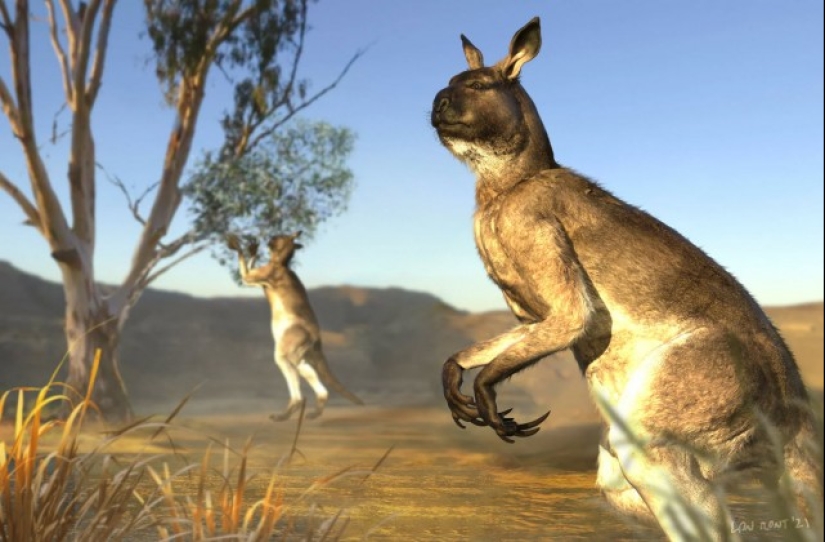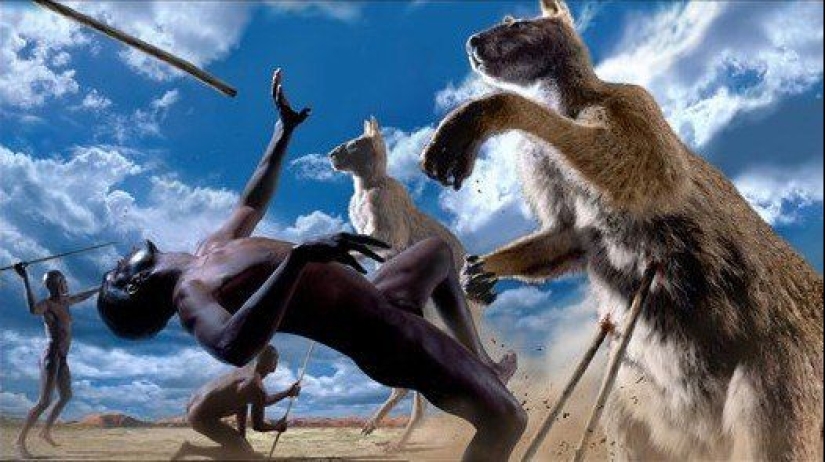The hoofed kangaroo procoptodon is an extinct giant of Australia
Categories: Animals
By Pictolic https://pictolic.com/article/the-hoofed-kangaroo-procoptodon-is-an-extinct-giant-of-australia.htmlAustralia is famous not only for the fact that almost all living things there dream of killing a person. Even on the Green Mainland, there are many marsupial animals that are not found anywhere else in the world. Once there were even more of them, but many species became extinct due to active human activity or for reasons unknown to science. One of the most unusual creatures in Australia, which disappeared about 18 thousand years ago, can be considered a giant kangaroo procoptodon-a creature that inspires both fear and bewilderment.

Imagine a kangaroo, 3 meters tall and weighing 200 kg, with a snout cut off like a bear's, powerful clawed front paws and one-toed hind legs, similar to a hoof, but with a long claw. Behind him, procoptodon had a powerful kangaroo tail, which he could lean on or use as a rudder, making giant jumps.

Using the tail as an additional support, the overgrown kangaroo could fight off its hind legs with dagger-claws not only from several hunters with primitive weapons, but also from a comparable-sized bloodthirsty predator. These animals also used their deadly hind legs in mating matches for the female.

Procoptodon cubs were born small and weak, so the females carried them in bags, as is customary with all kangaroos. When the baby began to move independently, he was for a long time near a strong and quick to kill mother, who jealously guarded her child from predators.

The Procoptodons were not particularly friendly and seemed to lead a solitary life. These animals were looking for a mate to breed with, and then diverged again. So the huge kangaroos were easier to feed themselves, because their appetite was excellent. With his strong teeth, he ground the tough shoots of drought-resistant steppe and desert plants like millstones.

Forelimbs, long and with impressive claws, helped procoptodon to reach high-placed branches and deftly break them off. Stuffed with leaves and shoots, this kangaroo could easily overcome huge jumps of 20-30 km to find a reservoir for quenching thirst.

It seems that procoptodon is an ideal inhabitant of the deserts and semi-deserts of Australia, able to adapt to a variety of adversities and changes. But this is not so – the kangaroo colossus completely disappeared about 18 thousand years ago, around the same time when the continent was actively inhabited by people.

The first Australians, barely able to use a stick as a club, could not harm the Procoptodon population by hunting. But people settled in places where giants lived and fed for thousands of years, forcing them out of their usual habitat, rich in plant food. Perhaps there were other factors that accelerated the extinction of the strange marsupials.
Keywords: Animals | Kangaroos | Extinction | Aborigines | Giants | Continent | Australia and new zealand
Post News ArticleRecent articles

The next time you're at a dinner party and someone lays out different nuts, take a moment and let everyone know that many of the ...

Discussions have been going on about the origin of the Americans' nickname "Yankee" for a very long time. There are many versions, ...
Related articles

If you like pictures and Internet memes with animals, chances are you've heard of the popular Japanese artist and enthusiast ...

Nature is infinitely creative, but sometimes she's so like his own creation, she decides to repeat their children. Prikosatsya ...

Yes, Pets benefit our health and it is proven by science. Their very existence certainly makes us happier, but also prolongs life. ...

A nudist cruise isn't just a clothing-optional sea voyage; it's an entire subculture with its own rules, traditions, and ...